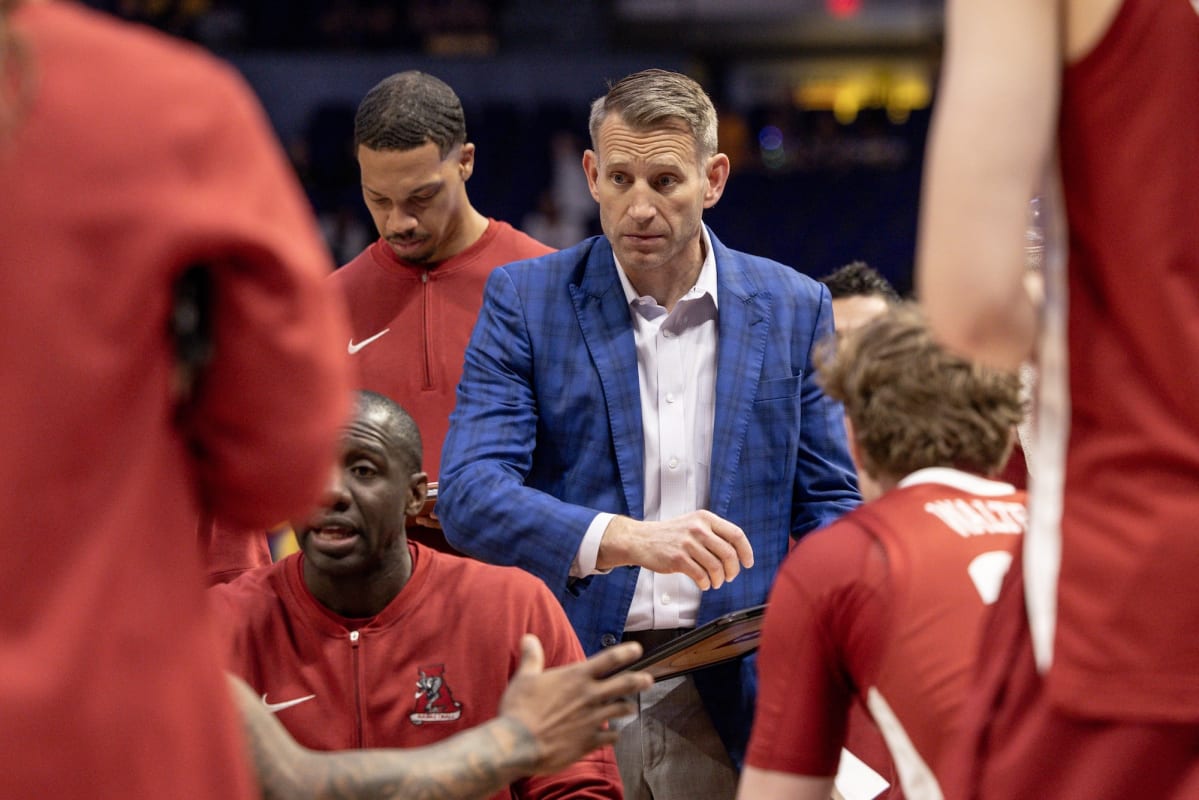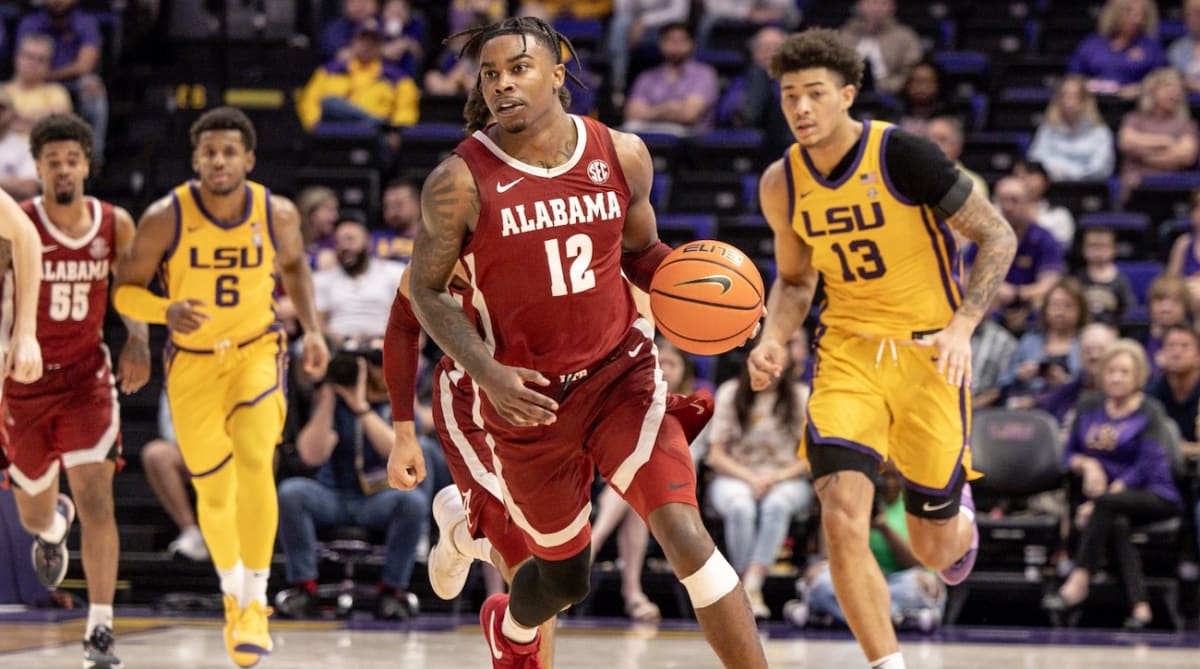When Nate Oats took charge of the Alabama Crimson Tide men’s basketball program early in 2019, he promised an offensive style few—if anyone—had ever seen in the SEC before.
Oats, the former high school math teacher turned rising coaching star, pitched Tide fans on a fast-paced offense built on transition baskets and plenty of made threes. Oats’s last team, the Buffalo Bulls, which had earned a near-unprecedented No. 6 seed in the NCAA tournament, took threes as more than 44% of their total shot attempts. Only one SEC team had even topped a 40% three-point rate in the previous 20 years: the ’07 Florida Gators team that won the national championship under Billy Donovan.
Unkept promises of aesthetically pleasing, fast-paced teams are a staple in introductory news conferences. Oats, however, was serious, and over the next four years he built one of the most dynamic offenses in the country on the principles of pace and space that have taken over the NBA. It helped him land a future No. 2 overall NBA draft pick in Brandon Miller, lead the Tide to a pair of SEC regular-season and tournament championships and even secure the No. 1 overall seed in the NCAA tournament in his fourth season in Tuscaloosa.

Stephen Lew/USA TODAY Sports
But Oats’s fifth year on the job has been, without question, his best coaching job yet. Consider all the obstacles in his way: Seven of his top-nine scorers departing either for the pros or the transfer portal; his projected starting point guard, Jahvon Quinerly, hitting the portal in late June; all three assistant coaches leaving for head coaching jobs; starting 6–5, the program’s first losing streak in nearly two years … the list goes on. Yet with March less than a week away, the Tide are positioned a game ahead of the field in the SEC title race once again. How? A supercharged offense that has gone from elite to historic, riding small ball to scoring totals not seen in college basketball in more than a decade. It’s the most extreme version yet of Oats’s heavy emphasis on threes and layups: Alabama attempts nearly half of its shots from beyond the arc and 92% of its shots from either the rim or from three, the latter of which is by far the highest mark of any high-major team.
“We’re not trying to be new, modern, whatever you want to call it. That’s not the goal. The goal is to be the most efficient offense we can,” Oats says. “I tell our players, we’re not playing fast just to play fast. That’s stupid. We’re playing fast because that’s the most efficient way to play. It’s the same with taking the threes. We’re not just firing up threes to be some novelty.”

The results are eye-popping. Alabama is averaging 91 points per game, a total no team has topped in 15 years. From an efficiency standpoint, the Tide’s offense is the fourth best in KenPom’s database, which dates back 25 years. The only three better: 2018 Villanova Wildcats, which won the national championship; ’15 Wisconsin Badgers and 1999 Duke Blue Devils, each of which lost in the national championship game.
This season’s Tide doesn’t have the surefire NBA talent last season’s team featured. Three mid-major transfers star in the backcourt now that former Cal State Fullerton Titans guard Latrell Wrightsell Jr. has entrenched himself as the team’s fifth starter, joining potential All-American Mark Sears (Ohio Bobcats) and Aaron Estrada (Hofstra Pride). Each mostly played with the ball in their respective hands during their time at lower levels and now share point guard duties under Oats, and all three are high-level three-point shooters. It’s unorthodox to play this small in the backcourt (all three stand 6’ 3” or shorter) but Oats wasn’t afraid to take that drastic step after his team’s early struggles, finally inserting Wrightsell into the starting lineup in late January instead of a traditional center like Nick Pringle or Mohamed Wague.
“All these different programs use it against us [in recruiting], they say we’re already all full of guards,” Oats says. “Well yeah, but we play four guards. They play one or two of them over there. Shouldn’t we have twice as many guards as their roster?”

Stephen Lew/USA TODAY Sports
With three ballhandlers, a sharpshooter (Rylan Griffen) as the nominal power forward and a stretch big in Grant Nelson playing center, Alabama becomes a nightmare for opponents to defend. All it takes is one of the Tide’s playmaking guards to generate an advantage off the bounce and all of a sudden, it’s either a pass to a three thanks to a helping defender or a layup.
“With all the spacing on the floor, we’re going to be able to get by our man,” Sears says. “Then, [just] make the wide-open read.”
That helps illustrate what Tide director of scouting and analytics Adam Bauman calls “the biggest misconception” about the high-scoring Alabama offense. Alabama may fire away from three more than just about anyone nationally, but that’s not the preferred shot in the Tide offense.
“The threes are a byproduct of our relentless pursuit of the rim and paint touches,” Bauman, a longtime Oats staffer dating back to their time at Buffalo, says.
Related: Men’s Bracket Watch: Clarity on Big East Bubble, Top Seed Flips
When the rim is taken away by defensive rotations, the Tide then settle for what they call “shrink threes,” catch-and-shoot shots from beyond the arc after the defense collapses. Those are incredibly efficient shots in the Oats offense. If a team drastically overemphasizes defending the rim, Alabama will take what it is given, like shooting 46 threes out of 64 shot attempts against the Purdue Boilermakers in December. When defenders stay home on the shooters, they’ll hammer away around the rim, attempting 52 twos and snatching more than 20 offensive rebounds Wednesday against Florida.
All this combines to put unyielding pressure on opposing defenses. Alabama’s rapid pace can wear you out, its shooters can blow you out and its toughness driving the ball can knock you out. No Alabama player will ever get pulled from the game for missing shots; instead, Oats has been known to yank a player for passing up an open look. Sears jokes that the first time he was pulled in such an instance, he didn’t even think he was open. But that’s part of the Oats magic: getting players to play with supreme confidence.
“He makes them, at times, believe they’re even better than they are, or better shooters than they are, or more consistent shooters than what the numbers say,” Bauman says. “He’s as good as anyone I’ve been around at instilling that in players.”
If nothing else, the Tide have created a model that has built consistently elite teams in regular-season play. Alabama had made just two of the previous 13 NCAA tournaments prior to Oats’s arrival, so winning multiple SEC regular-season titles and making a pair of Sweet 16 trips in his first four years is beyond impressive. This season’s success may be the greatest proof of Oats’s system’s stability, winning at an elite level without the future NBA picks his prior two top-tier teams had. For good reason, Oats considers winning the conference regular-season crown “the hardest thing” in college basketball. Climbing that mountaintop for the third time in four years at a non-traditional hoops power would be among the most impressive feats in the sport over that period.
Related: Forde Minutes: Emotions Run High and Don’t Mess With NCAA Tournament
But truly ascending to be considered among the sport’s elite requires March success. And while two second weekend trips shouldn’t be minimized, there’s plenty of skepticism that the Tide’s extreme style of play can deliver six straight wins in the Big Dance. Take last year’s stunning exit to the San Diego State Aztecs, when Alabama shot 3–27 from three. Taking “the right shots” translates to long run success, but in 40 minutes of single-elimination basketball with all the pressure on, variance can wreck a remarkable season in two hours. Is there a required stylistic shift in March, especially if the shots stop falling again?
“It’s [Oats’s] belief that if you haven’t talked about shot selection all year and then you talk about it in the NCAA tournament, what’s it going to do to a player? They’re going to tighten up, and that’s not what our thing is built on,” Bauman says.
“Sometimes there’s a luck factor involved in sports and you don’t want to overevaluate things when there’s not a whole lot to change,” Oats says.
Related: Houston-Baylor Could Help Decide Big 12 Title Race
It took incredible conviction for Oats to go all in on his analytically friendly methodology when he arrived in Tuscaloosa five years ago next month. Now, he’s doubling down in his hunt for a breakthrough, to a Final Four or even a national title. Is this March the be-all, end-all for Oats’s ambitious offensive approach? Perhaps not. After all, just being in position to contend given the turnover the Tide faced this offseason is remarkable. But internally, there’s belief that this season’s team, despite its unorthodox construction, is built to take that next step.
“We believe that this team, of any of the teams we’ve had, can [break through] because our offense has been more consistent,” Bauman says. “We believe in what we’re doing and we’re going to keep on doing it.”







